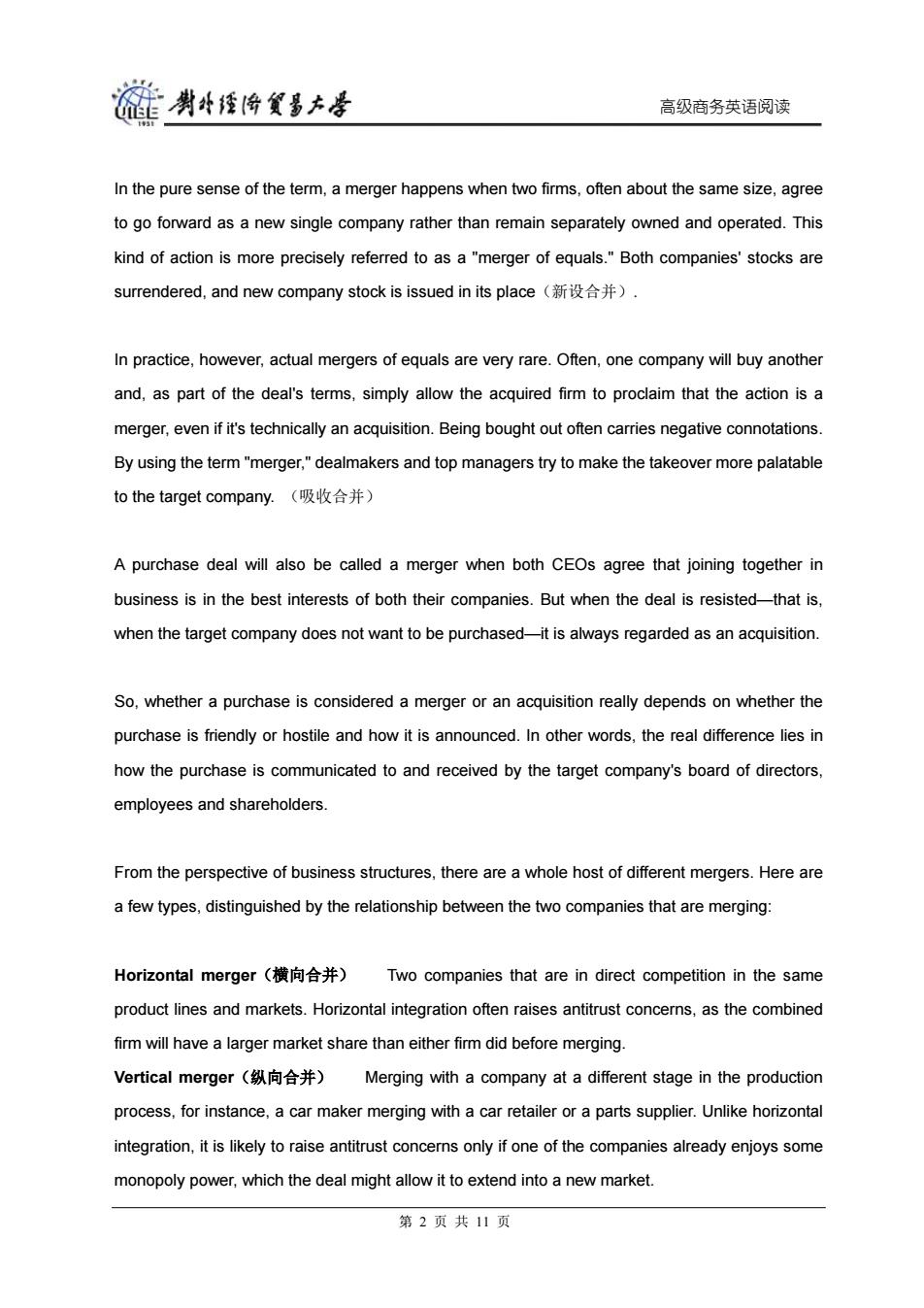正在加载图片...

链男牛经海食多大学 高级商务英语阅读 In the pure sense of the term,a merger happens when two firms,often about the same size,agree to go forward as a new single company rather than remain separately owned and operated.This kind of action is more precisely referred to as a"merger of equals."Both companies'stocks are surrendered,and new company stock is issued in its place(新设合并). In practice,however,actual mergers of equals are very rare.Often,one company will buy another and,as part of the deal's terms,simply allow the acquired firm to proclaim that the action is a merger,even if it's technically an acquisition.Being bought out often carries negative connotations. By using the term"merger,"dealmakers and top managers try to make the takeover more palatable to the target company.(吸收合并) A purchase deal will also be called a merger when both CEOs agree that joining together in business is in the best interests of both their companies.But when the deal is resisted-that is, when the target company does not want to be purchased-it is always regarded as an acquisition. So,whether a purchase is considered a merger or an acquisition really depends on whether the purchase is friendly or hostile and how it is announced.In other words,the real difference lies in how the purchase is communicated to and received by the target company's board of directors, employees and shareholders. From the perspective of business structures,there are a whole host of different mergers.Here are a few types,distinguished by the relationship between the two companies that are merging: Horizontal merger(横向合并)Two companies that are in direct competition in the same product lines and markets.Horizontal integration often raises antitrust concerns,as the combined firm will have a larger market share than either firm did before merging. Vertical merger(纵向合并)Merging with a company at a different stage in the production process,for instance,a car maker merging with a car retailer or a parts supplier.Unlike horizontal integration,it is likely to raise antitrust concerns only if one of the companies already enjoys some monopoly power,which the deal might allow it to extend into a new market. 第2页共11页高级商务英语阅读 In the pure sense of the term, a merger happens when two firms, often about the same size, agree to go forward as a new single company rather than remain separately owned and operated. This kind of action is more precisely referred to as a "merger of equals." Both companies' stocks are surrendered, and new company stock is issued in its place(新设合并). In practice, however, actual mergers of equals are very rare. Often, one company will buy another and, as part of the deal's terms, simply allow the acquired firm to proclaim that the action is a merger, even if it's technically an acquisition. Being bought out often carries negative connotations. By using the term "merger," dealmakers and top managers try to make the takeover more palatable to the target company. (吸收合并) A purchase deal will also be called a merger when both CEOs agree that joining together in business is in the best interests of both their companies. But when the deal is resisted—that is, when the target company does not want to be purchased—it is always regarded as an acquisition. So, whether a purchase is considered a merger or an acquisition really depends on whether the purchase is friendly or hostile and how it is announced. In other words, the real difference lies in how the purchase is communicated to and received by the target company's board of directors, employees and shareholders. From the perspective of business structures, there are a whole host of different mergers. Here are a few types, distinguished by the relationship between the two companies that are merging: Horizontal merger(横向合并) Two companies that are in direct competition in the same product lines and markets. Horizontal integration often raises antitrust concerns, as the combined firm will have a larger market share than either firm did before merging. Vertical merger(纵向合并) Merging with a company at a different stage in the production process, for instance, a car maker merging with a car retailer or a parts supplier. Unlike horizontal integration, it is likely to raise antitrust concerns only if one of the companies already enjoys some monopoly power, which the deal might allow it to extend into a new market. 第 2 页 共 11 页